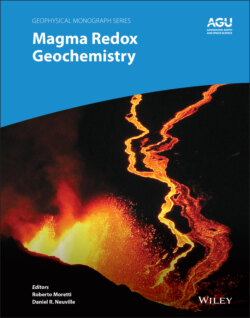Читать книгу Magma Redox Geochemistry - Группа авторов - Страница 14
1.1. GENERAL ASPECTS AND RATIONALE 1.1.1. Oxidation Number, Electron Transfer, and Half‐Reactions
ОглавлениеOxidation‐reduction (redox) geochemistry studies those natural reactions occurring on Earth in which the transfer of electrons determines a change in the oxidation number of participating chemical species. Oxidation state (or oxidation number) measures the degree of oxidation of an atom in a substance and it is the (hypothetical) charge of an atom if all bonds to atoms of different elements were 100% ionic, with no covalent bond fraction. The oxidation state of an atom is indicated with Roman numerals, whereas Arabic numbers are used for the charge on compound (e.g., in SiO44–, silicon has oxidation number IV and oxygen has –II, whereas 4– is the formal charge of the whole silicate ion). Charge and oxidation number are the same for monoatomic ions. The oxidation number can be positive, negative, or zero, and it can have a fractional value as well, and although very similar, it does not correspond to valency, which is an atom property and represents the number of bonds the atom needs to become stable, i.e., to complete either duplet or octet rule.
Many redox reactions are familiar to us, such as fire and combustion, rusting, and dissolution of metals. Transition metals and main group elements (e.g., N, halogens, O, S, C) have multiple oxidation states and important redox chemistry, which affect element distribution within the geochemical shells on Earth but also through the boundaries between such shells (e.g., Moretti et al., 2020a). For instance, it is the redox state of metals and ligands that complex them, which then determines (i) their “unlocking” from pristine reservoirs (e.g. minerals in which they occur at trace level); (ii) their mobility on Earth through carriers such as magma, water, or vapor; and eventually (iii) their accumulation and precipitations in new phases making up ore deposits.
Redox reactions involve a coupled transfer of electrons, so for any oxidation (loss of electrons) a reciprocal reduction (gain of electrons) occurs. Moreover, redox reactions naturally occurring on Earth involve a net chemical change that can be described not only via the exchange of electrons between ions or their complexes, but also of oxygen and/or hydrogen atoms and compounds that these can form (e.g., Cicconi et al., 2020a and references therein). Here are some examples:
(1.1)
(1.2)
(1.3)
(1.4)
(1.5)
In which the subscripts s, m, aq, and g refer to solid, melt, aqueous, and gas (including supercritical fluids) phases, respectively. In the five examples above, O2(g), H2O(g), Fe3+(aq), O2(g) and SO2(g) are oxidizing agents, whereas Fe(s), FeO(l), H2(g), Fe2+(aq) are the reducing agents.
The word oxidation was introduced by Antoine Lavoisier (1777) and indicates the chemical mechanisms in which oxygen is consumed and added to a compound. The parallel mechanism in which some other compounds loose oxygen was called reduction. The oxidation number of reaction components in Reactions 1.1 to 1.5 shows that some elements have a greater affinity for electrons than others and that oxygen tends to appear with oxidation number –II in its compounds (including the O2– species in its ionic compounds). In contrast, hydrogen tends to appear with oxidation number I. Besides, hydrogen and oxygen atoms and their compounds in reaction are related to ligands making up the most important matrixes on Earth, such as aqueous solutions (including highly concentrated saline solution), supercritical fluids and gases, silicate melts or oxide, and silicate minerals making up rocks. Except for rocks, these matrixes are also important transport agents and thus redox carriers within Earth geochemical reservoirs and throughout their boundaries. Therefore, nearly all redox exchanges on Earth are related to chemical transfers involving hydrogen‐ and/or oxygen‐based half‐reactions such as (Cicconi et al., 2020a,b):
(1.6)
(1.7)
that we will call henceforth oxygen and hydrogen electrodes (e.g., Cicconi et al., 2020a; Moretti, 2020) and in which the electron exchange is made explicit. For example, Reaction 1.1 can be written as the sum of Reaction 1.6 and:
(1.8)
plus the formation of FeO oxides from its ions,
(1.9)
in which oxidation numbers and then formal charges of involved atoms do not vary.
In ore geochemistry, but also in metallurgical practice, a special mention must be made to redox mechanisms involving chalcophile elements and sulfide. Most often, relevant equilibria are written without the involvement of the medium in which they actually occur. Pyrite formation can result from the hydrothermal alteration of igneous pyrrhotite, but their equilibrium can be simply written in the sole Fe–S system as (Barton, 1970):
(1.10)
In the Fe–S system, pyrite is not at the liquidus (pyrite does not melt), but as a conceptual exercise we can still relate its formation to the occurrence of the following fictitious half‐reactions in the solid phase involving sulfide and polysulfide anions:
(1.11)
(1.12)
and their combination with iron, which appears in its cationic form Fe2+ in both sides of Reaction 1.10. In the liquid state, melts in which sulfide is the main or the sole anionic ligand are very scarcely represented on Earth and segregate from reducing sulfur oversaturated magmatic silicate melts (e.g., Li and Ripley, 2013 and references therein). Instead, sulfide melts are of interest in extractive metallurgy (e.g., Sokhanwaran et al., 2016).
